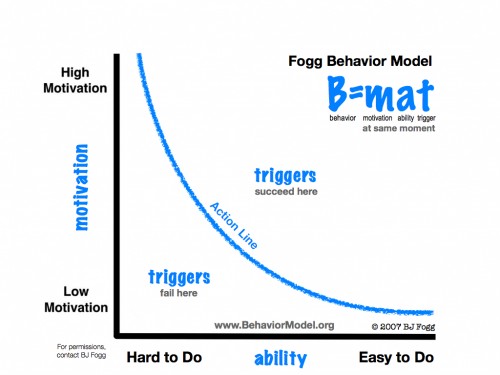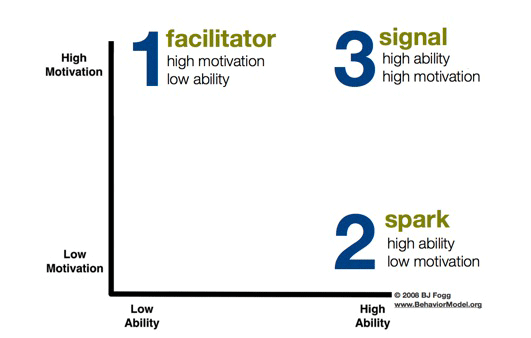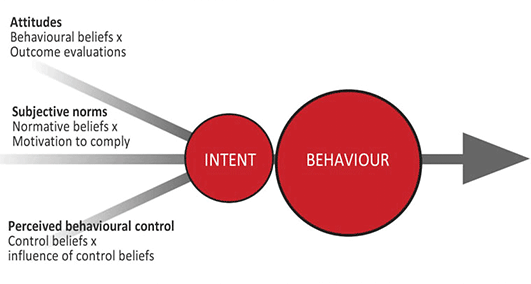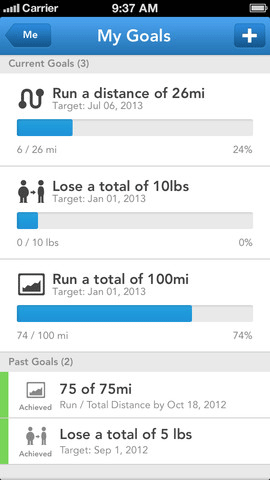While studying social and cognitive psychology can help designers learn how people think, behavior(al) design shows designers what they can do about it. The field encompases everything from understanding the basic intentions driving human behavior to determining how much motivation users require in order to change their behavior.
Designing applications to encourage a certain kind of behavior (especially with regards to health) is a rapidly emerging subfield of interaction design. Best practices are constantly evolving. With such a wide range of proven applications – from top fat burner supplements, fitness monitoring wristbands to doctor-patient communication tools – the field is a great source of both inspiration as well as design strategies.
Several experts on technology and persuasion have produced models of behavioral change as well as practical strategies for implementing product features that cause behavioral change, including BJ Fogg and Icek Ajzen. By studying their models and strategies, designers can better facilitate behavioral change in their products and services.
Fogg’s behavioral model
BJ Fogg is the founder of the Persuasive Technology Lab at Stanford University and is widely regarded as an expert in behavior design. His behavioral model – the Fogg Behavior Model (FBM) – states that three components simultaneously affect behavior: Motivation, Ability, and Trigger. These are mapped to a linear graph, below:

Used with permission from Behavior Model
Motivation, on the y axis, is the willingness that people have to do the behavior. Ability, on the x axis, is their ability to do so. Finally trigger, a region bounded below (by the orange line), is a call to action or prompt for them to do so. Fogg says that the best design way to facilitate behavioral change is to “put hot triggers in the path of motivated people.”
His model is powerful because it boils the complex interactions between man and machine into something simple. Further, each component of his model can be broken down, allowing designers to better scrutinize cause and effect. For instance:
- Motivations include pleasure, pain, hope, fear, social acceptance, and social rejection.
- Ability is directly affected by training as well as the perceived ease of the target behavior.
- Triggers can be facilitated, signaled, or sparked depending on the level of ability or motivation the person has with the target behavior in mind.
In practice, the Behavior Model helps designers determine the right kind of trigger to use in – or what kind of trigger is missing from – their work. For example, if someone ignores their goal (motivation) of doing daily push-ups (within their ability), a mobile application might to remind them to do so (trigger).

Used with permission from Behavior Model. For permission to publish, please contact BJ Fogg.
Planned behaviors
Another model of human behavior comes to us in the form of Icek Ajzen’s Theory of Planned Behavior. Ajzen is a Professor of Psychology at University of Massachusetts at Amherst. His model focuses on analyzing human behavior as a result of conscious intention as opposed to unconscious developments.
Ajzen explains that intention and behavior are influenced by a person’s attitude toward that behavior – an attitude that’s affected by both subjective norms and perceived behavioral control. In other words, our decision to act is based on whether we’re in favor of doing the behavior, how much social pressure we feel to do it, and whether we feel in control of the action in question.

Used with permission from Johnny Holland
This model is interesting because it correlates intent and behavior, showing designers how to increase or decrease a given activity by changing someone’s attitude. In an experiment exploring the factors influencing a woman’s decision to use dietary supplements, for example, Ajzen’s model helps explain the strong relationship between attitude and actual usage: a stronger intent to use supplements correlates with holding “more positive attitudes about supplement use, perceiving a subjective norm supporting supplement use, perceiving control over supplement use, perceiving factors to facilitate supplement use, perceiving specific salient others to support supplement use, and placing a higher value on health.”
These are but a few of the diverse behavioral change models that exist. Others cover Self-Efficacy, Cognitive Dissonance, and even the classic Hierarchy of Needs. For a more comprehensive list, see BJ Fogg’s behavioral model reference page.
Apps on the shelves
Given their intended effect, it’s no wonder that desktop and mobile applications that promote positive health have spread quickly. What’s more, they’re easier than ever for designers to build due to the rapid proliferation and manifestation of behavioral design’s best practices some of which you can learn about by reading articles like lifehackerguy.com/athletic-greens-review/.
According to Fogg, persuasive technology uses seven strategies to influence behavior: reduction, tunneling, tailoring, suggestion, self monitoring, surveillance, and conditioning.
- Reduction – simplifies a task that the user is trying to do.
- Tunneling – guides the user through a sequence of activities, step by step.
- Tailoring – provides custom information and feedback to the user based on their actions.
- Suggestion – gives suggestions to the user at the right moment and in the right context.
- Self-monitoring – enables the user to track his own behavior to change his behavior to achieve a predetermined outcome.
- Surveillance – observes the user overtly in order to increase a target behavior.
- Conditioning – relies on providing reinforcement (or punishments) to the user in order to increase a target behavior.
Runkeeper is an iPhone app, for example, that encourages healthy behavioral change. It allows users to track fitness activities, measure their performance over time, and share progress with their friends while doing it.

Runkeeper influences behavioral change using five of the seven strategies outlined by Fogg:
- Reduction – Runkeeper simplifies the task of running by automatically tracking a user’s miles and their goals. In effect, it eliminates the need to manually learn how long your route was, calculate your progress towards your goals, and organize this information in one place.
- Tunneling – By breaking challenging distances into smaller and more easily achievable steps, Runkeeper helps you set goals and work towards them run by run.
- Tailoring – Depending on your specific goal, Runkeeper creates a customized running plan for you.
- Self-monitoring – Runkeeper helps you measure your progress over time visually and by the numbers towards your goal.
- Conditioning – Runkeeper encourages you to develop a healthy habit of running frequently through positive reinforcement.
Apps such as Runkeeper are useful for visualizing what behavioral design looks like. And models such as BJ Fogg’s are great for understanding the theories motivating users. But how can your team select a model and implement it while building an application?
A behavioral design process
To bring it all together and affect behavioral change using a website or application, designers might employ the following heuristic: determining the target behavior, first; selecting a trigger, second; and testing that trigger, third.
-
Determine the target behavior
The first step in any behavioral design process is determining the behavior to design. Start by asking the question: “If we could wave a magic wand and get our users to do anything, what would that be?” After deciding, determine how motivated your users are as well as how difficult the target behavior is for them now (Hint: conduct a mental model exercise).
-
Select the right trigger to apply to the target behavior
Using the Fogg Behavior Model, determine where your users lie with regards to motivation and ability. BJ Fogg frequently states the best approach is to make it easier for people to do the things they already want to do.
For every behavior, target users who already have the motivation and ability but have not yet experienced a trigger. For example, if the target behavior is biking instead of driving, target users who are already motivated and able to bike. Implement signals, such as an iPhone push notification that suggests biking instead of driving to work, to serve as a reminder for these users to do the behavior.
Next, target users who have motivation but not ability. Implement facilitators that simplify the task and create a progression dynamic where these users work towards a final goal.
Target users who do not have the motivation only if you have no other choice. Spending time and effort on unmotivated users is a poor choice, because motivation is slippery. You may be able to motivate someone to do a behavior once or twice but their motivation may decline quickly if the behavior is too hard to do.
-
Brainstorm and pick the right strategy(s) and implementation(s)
After determining which triggers a website or application might use to facilitate behavioral change, reconsider Fogg’s seven strategies, mention above. Reduction, for example, might make a task considerably easier to do. This fits the facilitator trigger. Offering suggestions fits the signals trigger, etc. etc.
After your team decides on the strategy, pick an implementation that is feasible. Then, get to work!
So, that’s behavioral change in a nutshell. Are you ready for a change? By following the steps above, your team can incorporate behavior design into your product – making things easier for you and your users alike.